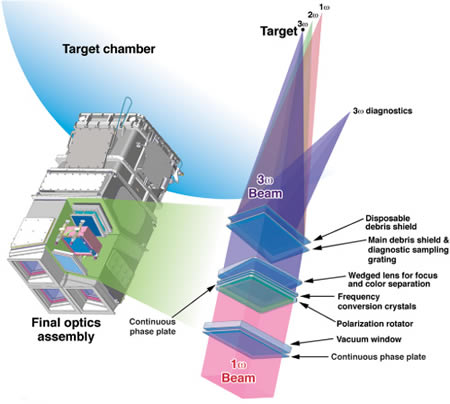Final Optics

Converting and Focusing the Beams
The final optics assemblies (FOAs) are the last element of the main laser system and the first of the target area systems. Each FOA contains four integrated optics modules (IOMs) that incorporate beam conditioning, frequency conversion, focusing, diagnostic sampling, and debris shielding capabilities into a single compact assembly. These optics are shown in the figure below.

The FOAs mount to the NIF Target Chamber and house the final set of optics for four NIF beamlines as line replaceable units; each optic can be individually replaced as required. New methods of fabricating, grinding, and polishing were required to produce optics that could withstand NIF’s extremes of energy and power.
NIF’s 192 beamlines connect to the Target Chamber in groups of four through the 48 FOAs. The FOAs are symmetrically distributed around the upper and lower hemispheres of the Target Chamber so that the laser beams are optimally located to provide the proper orientation as they are directed toward the target. Adjustments of the final turning mirrors allow pointing the focused beams to different locations near Target Chamber Center (± 3 centimeters) to accommodate a variety of experiments.
One of the chief functions of the FOAs is to change the laser light to a shorter wavelength. NIF’s neodymium glass lasers generate light at a fundamental wavelength of about 1,053 nanometers (one omega, or 1ω) in the infrared region. Inertial confinement fusion targets, however, perform more efficiently when they are driven with 351-nm ultraviolet light (3ω).
To change the laser light frequency, the 1ω light passes through two crystal plates made of potassium dihydrogen phosphate (KDP), the same type of crystal used in NIF’s Pockels cell optical switch (this process is based on the nonlinear optical response of KDP to high-power laser light). The first plate converts two-thirds of the 1,053-nanometer radiation to the 527-nm second harmonic (2ω) wavelength, which is visible green light. The second crystal then mixes that radiation with the remaining infrared light to produce 351-nm ultraviolet radiation at the third harmonic (3ω).
Other functions of the FOAs are also critical to achieving the required laser performance for use in target experiments. In all, the FOAs provide a vacuum barrier for the Target Chamber, convert 1ω to 3ω light, focus the 3ω light to Target Chamber center in a shape consistent with the experimental requirements, allow for beam smoothing, allow for 3ω power and energy measurement, and provide a protective shield from target debris.
Replacement of each final optic is done using specialized clean cassettes that can be attached to the IOM hatches.
More Information
“NIF final optics system: frequency conversion and beam conditioning”
Next Up: Target Chamber



